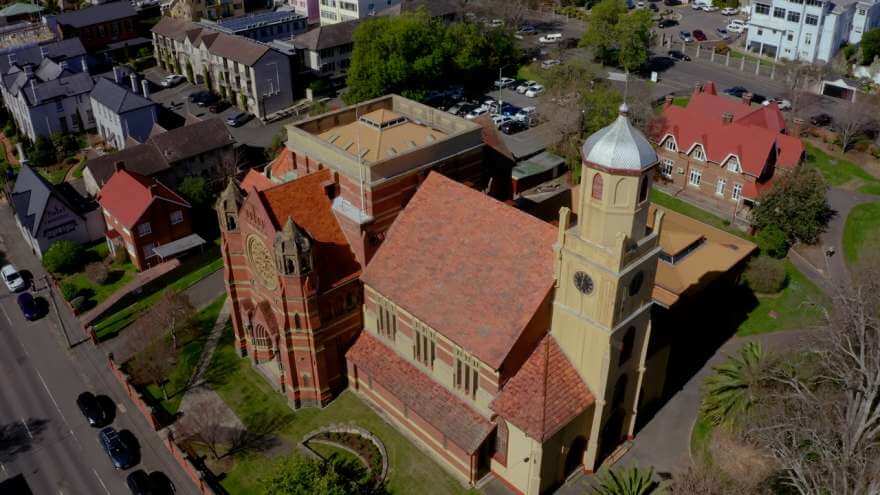St John’s Launceston turned to GUZ BOX design + audio to propose an audio solution that would provide clear intelligibility in the main seating areas
As the first European settlements rose out of the virgin landscape of northern Tasmania in the early 19th century, St John’s claimed its stake as the oldest church in Launceston. Celebrating its 200th anniversary in 2024, the church committee decided to conduct extensive refurbishment ahead of the bicentennial celebrations. To enhance speech intelligibility, All Saints Anglican Network tasked GUZ BOX design + audio to propose architectural acoustic and electroacoustic design works in late 2020.
Unlike the intelligibility, the realworld challenges were clear for GUZ BOX design + audio founder, Tim Kuschel. Armed with few documents and hindered by the numerous pandemic restrictions in place at the time, the Canberra-based consultant was forced to work on modelling from point cloud data transferred to him. During a relaxation of pandemic restrictions in March 2021, Kuschel was almost overwhelmed by the heritage-listed architectural constraints and demanding acoustics, including a 22m-high dome.
“The dome and rising stone pillars combined to create multiple reflections and, with a pipe organ still in use, intelligibility was a major concern,” recalls Kuschel. “A large proportion of the congregants are elderly worshippers, and the majority could not understand the spoken word services. Therefore, the design brief focused on speech intelligibility within the main seating areas. Additionally, the existing audio system was deemed to possess limited flexibility, so I was requested to add enhanced features into the design.”
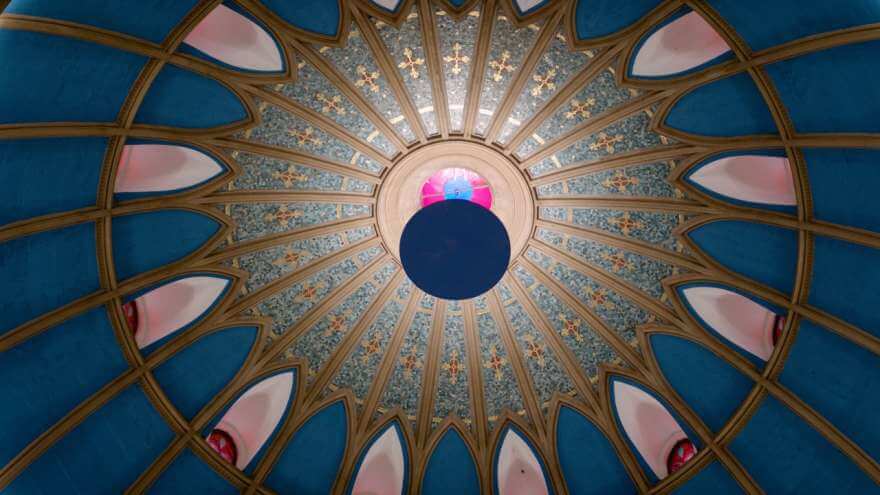
St John’s also hosts more contemporary music for its youth services and others during weekday evenings. Although the church is one of the oldest-surviving churches in Australia, it has received numerous extensions and modifications over the years. Only the tower and first pair of windows in the nave remain from the original 1824 construction. “Just as the church has added new extensions at various points in time, random loudspeaker enclosures have also been installed into various zones. The existing loudspeaker system simply did not meet the requirements because it consisted of too many non-compatible enclosures, which were not designed for such a space.”
The proposed works to upgrade and revise the sanctuary, platform and presentation area included an acoustic amenity supporting a modern contemporary worship style. Demanding a minimalist audio reinforcement footprint, the architectural and audio aesthetic for traditional un-amplified musical performances would need to be adhered to. A flexible AV system was also required to distribute and replay video content, including the broadcast and livestreaming of church activities and special events, from multiple camera locations to presentation screens.
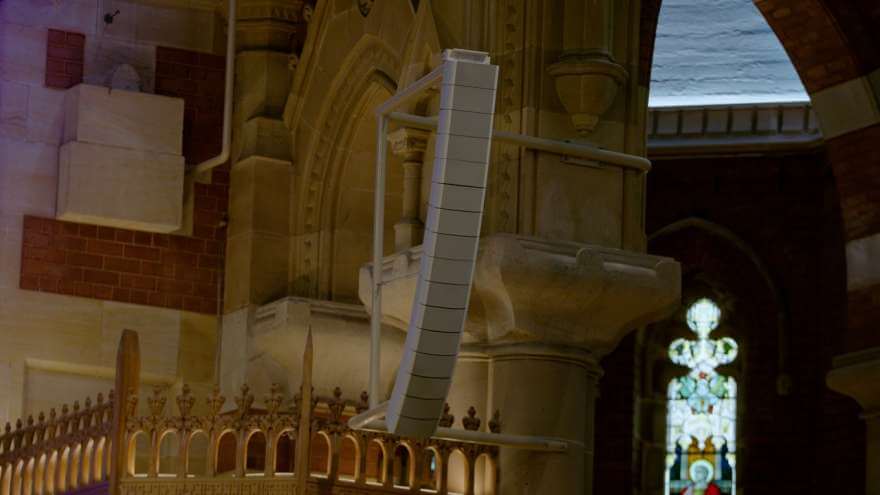
To create detailed acoustic design and modelling using EASE software, Kuschel conducted extensive acoustic measurements. A man driven by detailed figures, Kuschel carefully studied the reflective surfaces and the acoustic materials. Not only was the audio system required to focus its energies on the main church seating areas, but the loudspeakers would also need to operate within the full frequency range for speech and music. Assuming a two-thirds
seating capacity, Kuschel set a desirable Speech Transmission Index (STI) of greater than 0.60 throughout the areas covered by the audio systems. The balcony, chapel, choir, entry and crèche areas were also specified to operate within a minimum frequency response of 150Hz–16kHz (±3dB).
Balloons were used to measure the impulse responses, with the results used to correlate real-world with virtual response measurements. In addition, Kuschel’s ears played a significant role in studying the acoustic behaviour during various services. “For the more social aspects, I listened to the pipe organ and I played the piano to comprehend how a performer perceived the sound onstage. Because my background is in architecture, I built a model in AutoCAD from the point cloud data before converting it into a virtual acoustic model using AFMG’s EASE version 5 software. For added accuracy, I correlated the physical measurements with the EASE model.”
To minimise the impact on the architectural design and aspects within St John’s, Kuschel worked closely with Cumulus Studio by proposing an extensive acoustic works treatment programme, including ceiling absorbers and wall treatments. “It would be very difficult to remove all the sound defects, including echoes, room nodes and focused reflections from curved surfaces and dome structures. The focused reflections from the curved wall and ceiling surfaces are a characteristic of the existing church acoustic environment.”
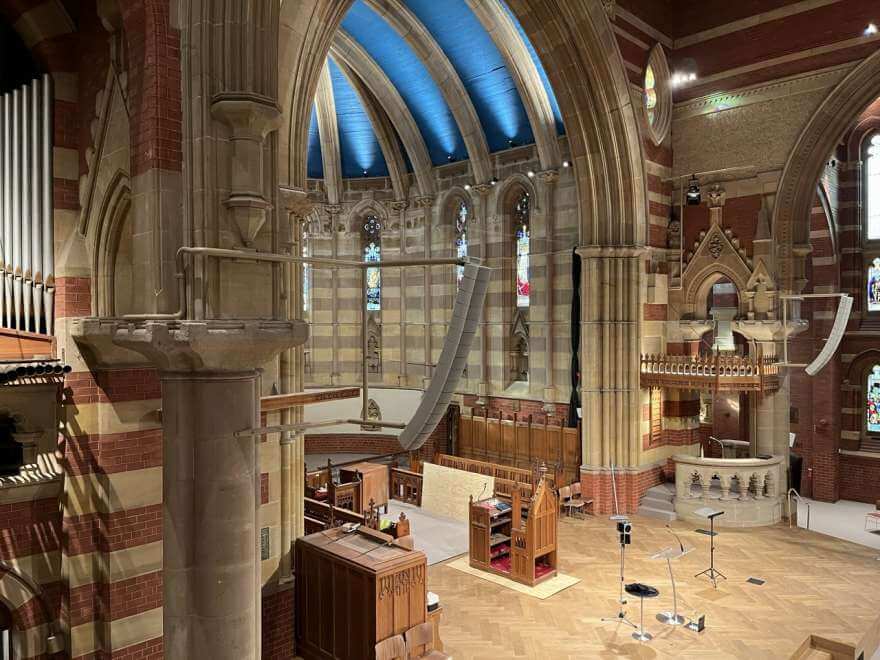
The Hobart-based architects wanted Kuschel to install technology that would simplify the setup for local artists looking to perform in the church. “I evaluated various sound systems for this space but, ultimately, the Martin Audio O-Line offered the most consistent results across the seating areas. With its small, compact form factor, O-Line excels in houses of worship or those venues where speech intelligibility is the primary function of the space. For the ability to reproduce music, however, additional subwoofers were required.”
Working closely with Martin Audio distributor Technical Audio Group (TAG), L-R Martin Audio O-Line arrays provide the main FOH coverage. Consisting of 16 elements in each array, each element comprises dual 3.5-inch LF with five 0.6-inch HF drivers. For the ability to reproduce music by enhancing the low-frequency spectrum, six SX110 10-inch directradiating sub bass arrays have been placed under the main platform.
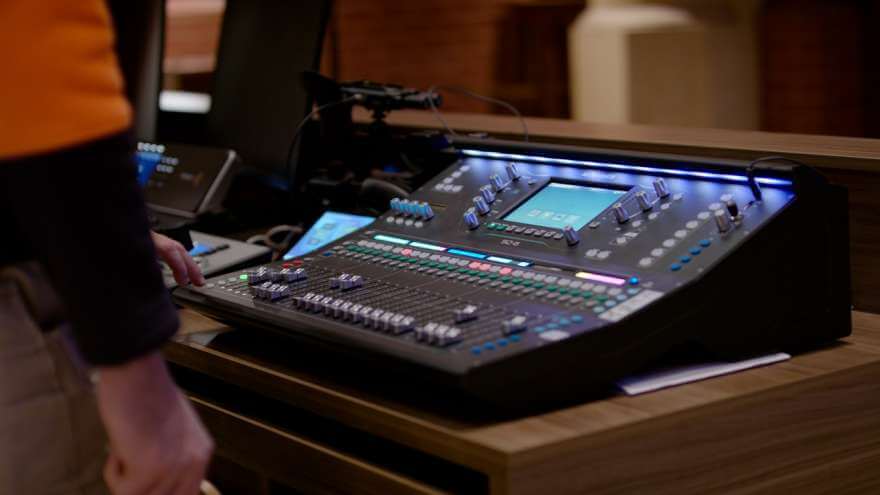
“We could not suspend the O-Line arrays from the 22m-high concrete dome, as it is 16m higher than the optimum speaker placement. For the desired coverage, the modelling suggested that the top speaker of each hang be suspended 6m above the sanctuary floor. To achieve this, customised speaker brackets were designed that extend the distance of the arrays from the wall.”
Several Martin Audio CDD6 and CDD5 cabinets have been fixed in the chapel and choir areas on ball and ceiling brackets. “To blend in with the décor, the conduits running the cabling to the wallmounted speakers are painted in the same finish. Alternative colours were painted to match the sandstone and the brickwork in some areas.” This was initiated by the builder and integrator to satisfy the requirements of heritage constraints.
DSP settings for each O-Line element, the subwoofers and the fill speakers have been set and stored within a Q-SYS Core 110fx 128×128 processor. Mounted on a tabletop, simplified control of the audio parameters can be made, for those with access codes, from a Q-SYS 7-inch PoE touchscreen. The GUI interfaces with the entire Cat6 networkable audio connections courtesy of a Netgear Q-SYS PoE+ 30-port managed switch.
Fitted with a Dante card, an Allen & Heath SQ-6 digital console is used for mixing both simple spoken word services and musical performances. A wireless iPad loaded with SQ MixPad app allows the presiding audio technician to independently or simultaneously control the SQ-6 console over a wired or wireless network. Microphone inputs are received via Cat6 connection from the S-Link port on the rear of the 48-channel console from the Allen & Heath DX164-W 4-in/16-out flush-mounted floor box expanders onstage.
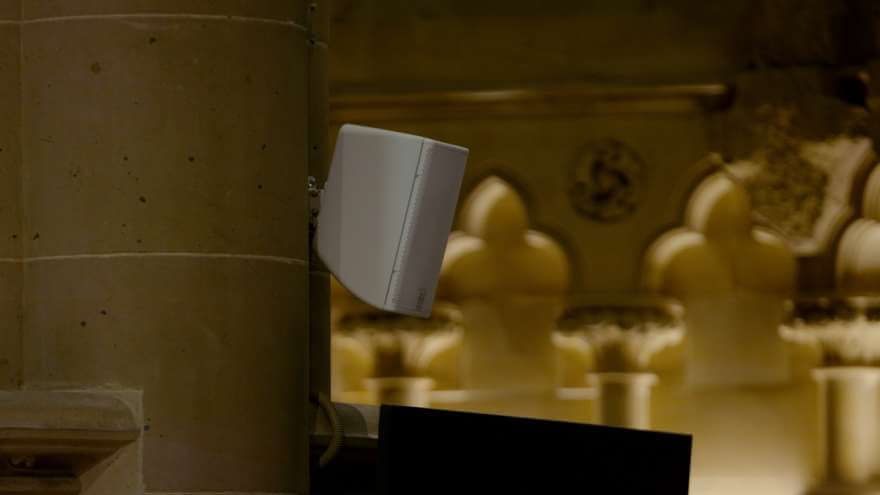
“When the FOH loudspeaker system is not required, the operator can select one of the Q-SYS presets. More advanced users can access the Dante network on the built-in SQ-6 touchscreen, which runs to a breakout box in the rack.”
Already possessing a large microphone inventory, Kuschel simply insisted on the adoption of a Sennheiser EW-DX wireless system. Boosted by an RF Venue diversity architectural antenna, MMD945 super-cardioid capsules and Que Audio DA12DE head-worn models connected to EW-DX bodypacks transmit to the EM4 4-channel Dante digital full-rack receiver. For spoken word, the lectern is fitted with Audio-Technica U857Q-H gooseneck microphones fitted to shock mounts.
Assistive listening is enhanced with the installation of Univox SLS-3 and SLS-5 phased-array induction loop amplifiers. Kuschel designed the placement to be as far from audio, video and data systems as possible. Consideration was also given to interference from under-floor heating systems. “Due to the magnetic field strength of induction loop systems, some of the audio equipment such as dynamic microphones and electric guitar pickups can be affected.”
The acoustic works included the replacement of the raised timber platforms towards the front of the church and in the chapel with 130m2 of recycled hardwood timber linings. Indirectly, the laying of 590m2 of new carpet throughout the ground-level seating areas and balcony sections provides added absorption. In addition to some wall treatments, Kuschel’s decision to apply an aesthetic acoustic treatment of Megasorber 50mm sound absorbing panels to approximately two-thirds of the ceiling over the main seating areas was fully merited during commissioning.
“The reverberant energy over the audience area has been controlled. Following the upgrade, the installed audio system provides a minimum measured STI value of 0.61 from the front row to the last seat of the balcony. The speech clarity is uniformly intelligible, whether you’re sitting in the main seating block, in the chapel or up in the balcony. Both live performances and high-definition spoken word services can be better managed.”
Following the acoustic treatment, Kuschel recorded 2.5s of reverberation time, mainly in the mid-frequencies. “The organist demanded reverberant energy in the space, and it was pleasing to note that this has been unaffected by the acoustic works. Crucially, however, the reflected energy has been controlled and so the performances of singers and musicians are no longer marred. There is a good natural reverberant tail which is more defined, but it doesn’t come with the early reflections that affect musicians.”
Installation works were carried out by Tasmania-based Contact Group, who have provided an exceptionally high-quality result considering the heritage constraints and detailed, time consuming installation. T-Built project manager Joel Taylor managed all the contractors and systems integrators onsite. “During the entire upgrade and refurbishment programme, Joel carefully coordinated all the trades onsite,” explains Kuschel. “The acoustic works and AV fit-out were managed to perfection under him. I cannot rate him highly enough.” A 10 out of 10 perhaps, for Taylor, but some aspects of an AV upgrade cannot be assessed or measured scientifically
Click here for original article.

